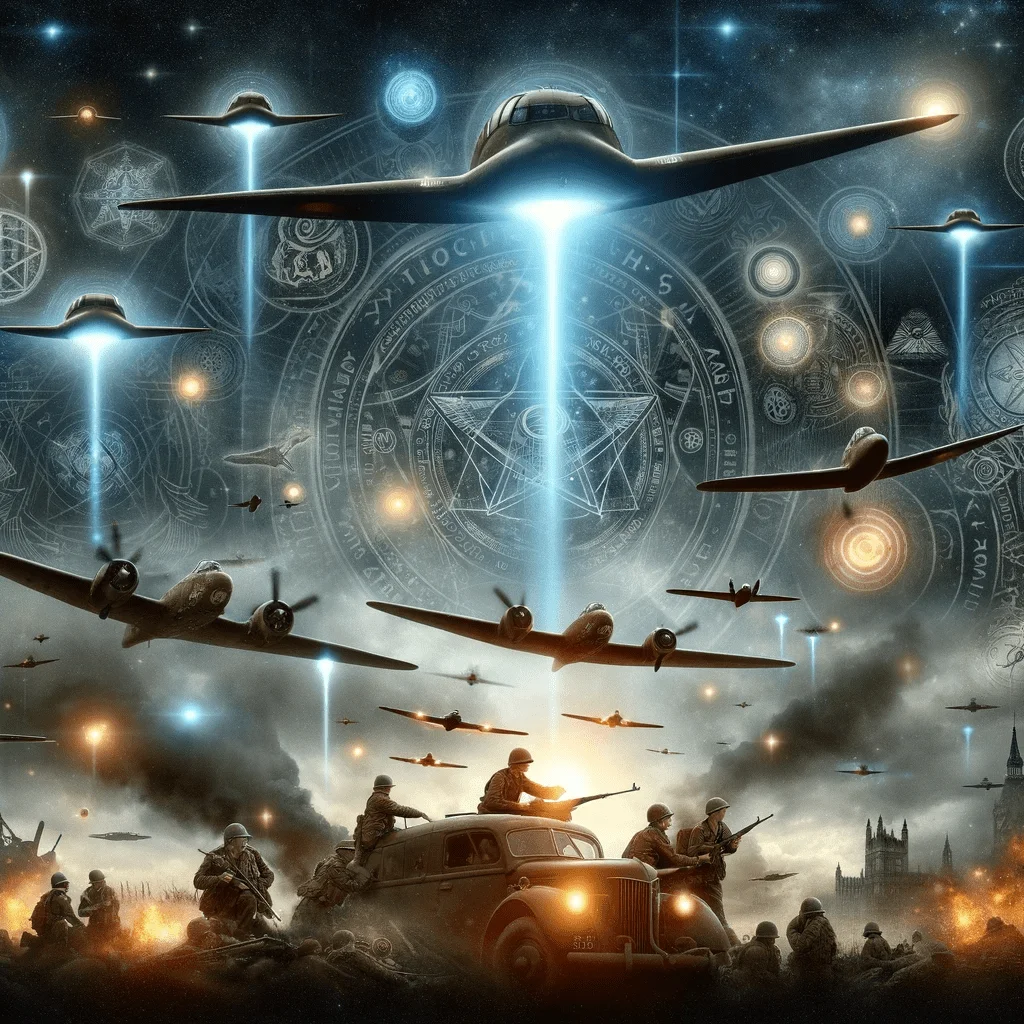World War II and UFO

The World War II era was a time of great conflict, with many nations at war and people all around the world grappling with the impact of this unprecedented event.
World War II was a global conflict that lasted from 1939 to 1945, involving the majority of the world’s nations, including all of the great powers. The war resulted in a staggering number of casualties, both military and civilian. Here is a breakdown of the estimated number of deaths and casualties by country:
- Soviet Union: 27 million deaths (including military and civilian)
- China: 20 million deaths (including military and civilian)
- Germany: 5.5-6.9 million deaths (including military and civilian)
- Poland: 5.6 million deaths (including military and civilian)
- Japan: 2.5-3.1 million deaths (including military and civilian)
- Yugoslavia: 1.4 million deaths (including military and civilian)
- France: 567,000 deaths (including military and civilian)
- United Kingdom: 450,000 deaths (including military and civilian)
- Italy: 492,000 deaths (including military and civilian)
- United States: 418,000 deaths (including military and civilian)
The total number of deaths in World War II is estimated to be around 70-85 million, making it one of the deadliest conflicts in human history.
As strange as it sounds, during World War II, both the Allied and Axis powers explored the potential of the occult, including astrology, mysticism, and psychic phenomena, to gain an advantage in the conflict. The use of occult practices and beliefs during wartime is a fascinating and lesser-known aspect of history, and it highlights the complex web of psychological warfare, deception, and manipulation that took place during the period.
In Nazi Germany, there was a strong interest in the occult among high-ranking officials, including Heinrich Himmler, who was known to have a deep fascination with mysticism and ancient Germanic lore. The SS, under Himmler’s direction, conducted research into various occult practices, including astrology, and there were instances where astrologers were consulted for strategic guidance. The Nazi regime believed that tapping into the power of the occult could help them achieve their objectives and solidify their control over Europe.
Karl Ernst Krafft, a Swiss astrologer, was one of the individuals enlisted by the Nazis to provide astrological advice during the war. He gained prominence after predicting an assassination attempt on Hitler in 1939, and subsequently became involved in various propaganda and psychological warfare efforts. Another notable figure was Erik Jan Hanussen, a Jewish psychic and astrologer who was rumored to have advised high-ranking Nazi officials, including Adolf Hitler himself.
On the Allied side, British intelligence sought to exploit the enemy’s interest in the occult by employing astrologers and psychics in various deception and counterintelligence operations. One example is the case of Louis de Wohl, a Hungarian-born astrologer who worked for the British intelligence service. De Wohl was tasked with creating and distributing false astrological predictions designed to undermine the Nazis’ faith in astrology and sow confusion within their ranks. By doing so, the British hoped to manipulate the enemy’s decision-making process and gain an upper hand in the conflict.
In the United States, the interest in the occult led to the creation of the Office of Strategic Services (OSS) program called “Operation Stargate,” which aimed to investigate the potential military applications of psychic phenomena, such as remote viewing. Although this program did not officially begin until the 1970s, its roots can be traced back to the wartime interest in the occult and psychic powers.
After coming to power in 1933, Hitler began to rearm Germany, which had been severely weakened by the Treaty of Versailles that ended World War I. He also pursued an expansionist foreign policy, seeking to create a Greater Germany that included territories in Eastern Europe and the Soviet Union.
Nazi Germany was a regime that promoted an ideology of racial purity and superiority, in which the so-called “Aryan” race was seen as the pinnacle of human achievement. According to Nazi ideology, the Aryan race was defined as people of European descent who had specific physical and cultural characteristics, including fair skin, blonde hair, blue eyes, and a supposed capacity for creativity, intelligence, and leadership. The mythology of the Norse gods and heroes was seen as an expression of the spiritual and cultural essence of the Germanic people, and was used to promote the idea of a pure, Aryan lineage with roots in the ancient past.
The Nazis drew on Nordic mythology and other mystical traditions to promote their ideology of racial purity and superiority.
The Nazis believed that the ancient Nordic peoples had developed advanced technologies and forms of knowledge that were lost to modern society. They sought to uncover these ancient secrets in order to create a new, powerful civilization that would be based on the principles of racial purity and superiority.
The Nazis were also influenced by the writings of certain occultists and mystics who believed in the existence of a powerful, ancient civilization that had been destroyed by a cataclysmic event. They saw themselves as the heirs to this lost civilization and believed that they had a special destiny to create a new, utopian society based on the principles of racial purity and superiority.
There were a number of individuals who were responsible for promoting the ideas of Nordic mythology within Nazi Germany. One of the most influential was Heinrich Himmler, who was the head of the SS and oversaw the organization’s efforts to promote the idea of a pure, Aryan race. Himmler was particularly interested in the occult and esoteric teachings, and he believed that ancient Nordic civilization had possessed a vast knowledge of esoteric secrets that could be used to create a new, powerful civilization.
Another individual who was influential in promoting Nordic mythology was Alfred Rosenberg, who was a leading Nazi ideologue and the head of the Reich Ministry for the Occupied Eastern Territories. Rosenberg was a proponent of the idea that the Nordic race was superior to all others, and he sought to promote the idea of a new, pan-European civilization that would be based on the principles of racial purity and superiority.
There were also a number of other individuals within the Nazi party who were influenced by these ideas, including the historian and propagandist Otto Dietrich, the artist and architect Hermann Esser, and the philosopher and historian Ernst Krieck. These individuals played a significant role in shaping Nazi ideology and promoting the idea of Nordic mythology as a means of promoting racial purity and superiority.
Esoteric practices are a broad category of spiritual and mystical traditions that are often associated with secret or hidden knowledge. They are focused on the pursuit of spiritual growth and enlightenment, and often involve practices such as meditation, visualization, and ritual. Some esoteric practices that were popular in Germany during the Nazi era included divination, rune magic, and the study of ancient symbols and artifacts.
Against this backdrop, there were also reports of mysterious sightings in the skies, with many people witnessing what they believed to be Unidentified Flying Objects (UFOs).
Given the close ties between Benito Mussolini and Adolf Hitler, which intensified over the years, the likelihood of them sharing confidential information is high. This sentiment is underscored by their unified political and military aspirations. The 1933 crash in Italy, specifically in Lombardy, happened during a period when both leaders were exerting substantial influence. The inception of the Rome-Berlin Axis in 1936 and the signing of the “Pact of Steel” in 1939 bolstered their alliance, suggesting a possible timeframe during which details of the 1933 UFO crash might have been shared indicating blonde hair and blue eyed aliens.
One of the most famous examples of these sightings during the World War II era is the Battle of Los Angeles, which took place on February 25, 1942. According to reports, a mysterious object was seen flying over the city, leading to a barrage of anti-aircraft fire from US military forces. Despite the intense effort, the object was never successfully shot down and its identity remains a mystery to this day.
Another well-known incident from the World War II era is the Foo Fighters phenomenon. This term refers to mysterious objects that were seen flying in the skies over Europe and the Pacific theater of war. The Foo Fighters were described as glowing orbs or balls of light, and they were often seen flying alongside military aircraft, leading some to speculate that they were some kind of advanced technology being developed by one of the warring nations.
The extreme speed of a hypersonic metallic sphere could make it very difficult to defend against, as it could travel long distances in a very short amount of time and be difficult to track or intercept. Additionally, the kinetic energy of a hypersonic weapon could be very high, allowing it to penetrate through hardened structures or other barriers and inflict significant damage.
World War II era and UFO/UAP sightings:
- The German Luftwaffe kept detailed records of their encounters with UFO/UAPs during the war, which are now kept at the German Federal Archives. (Source: German Federal Archives)
- The Foo Fighters phenomenon was widely reported by US, British, and German military personnel, leading some to believe that they were not the result of misidentifications or hoaxes. (Source: Smithsonian Magazine)
- The Japanese military also reported encounters with UFO/UAPs during the war, with some incidents being documented in official reports. (Source: War History Online)
World War II era is an interesting and mysterious chapter in the history of UFO/UAP sightings.
Operation Paperclip was a secret program launched by the United States government after World War II, aimed at recruiting and bringing German scientists and engineers to America to work on various military and scientific projects. The program was initiated in 1945 and continued for several years, during which more than 1,600 German scientists and their families were secretly relocated to the United States. The scientists were chosen for their expertise in fields such as rocketry, aerodynamics, and biological warfare, and were assigned to work on projects for the U.S. military and intelligence agencies.



